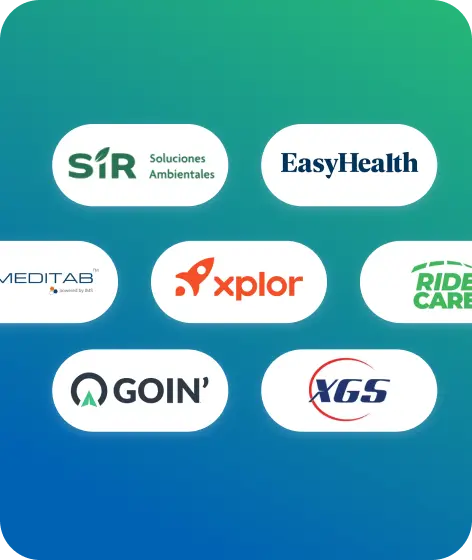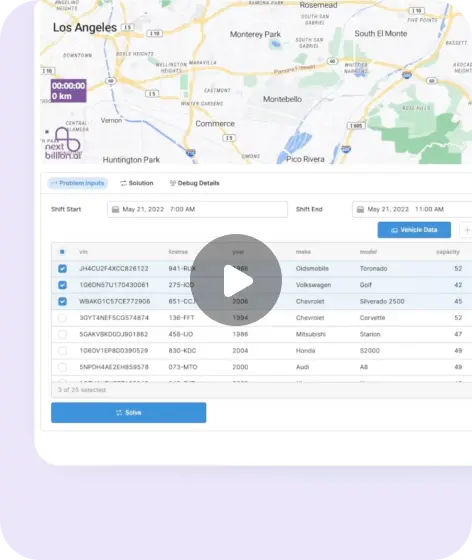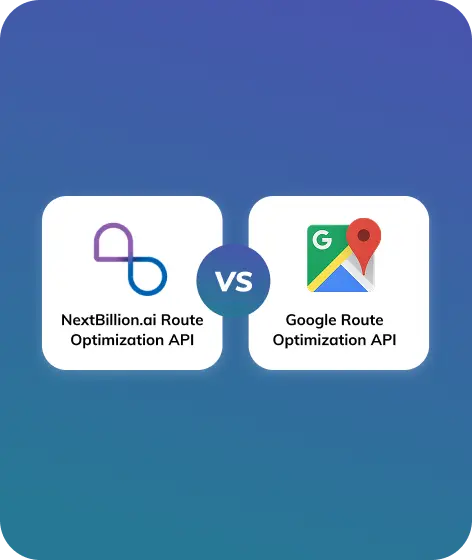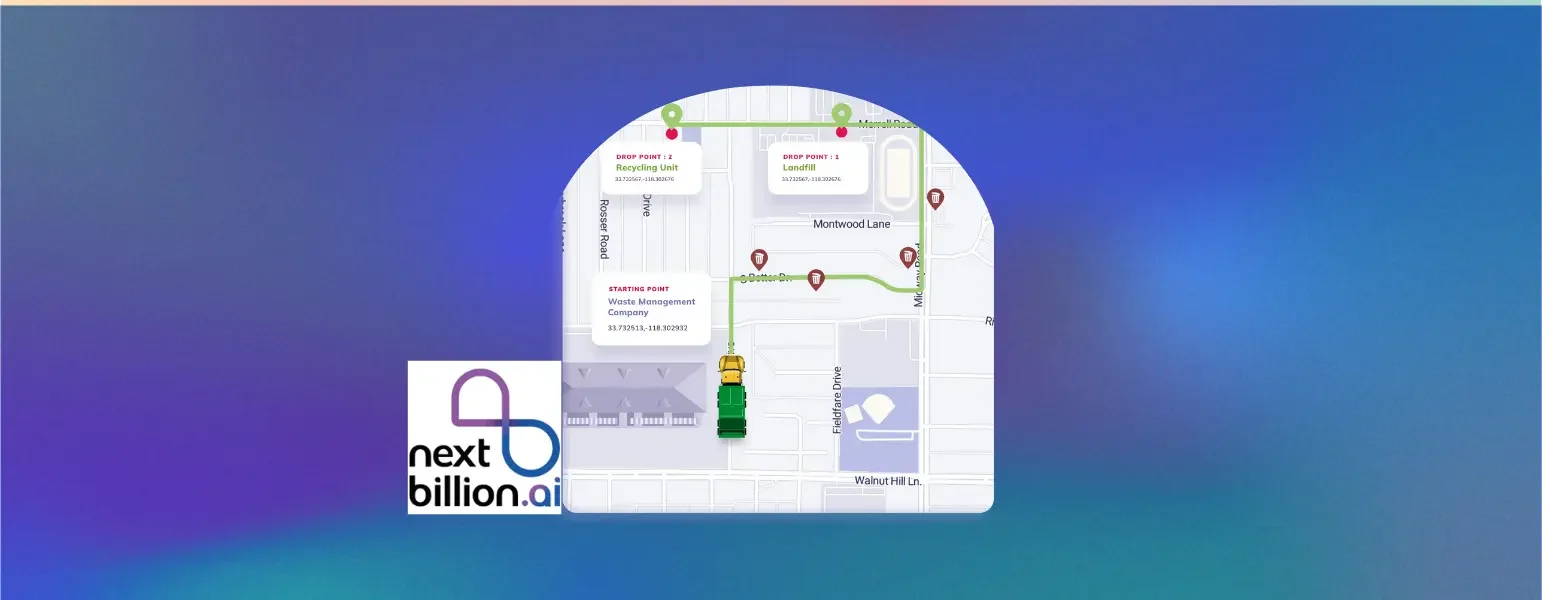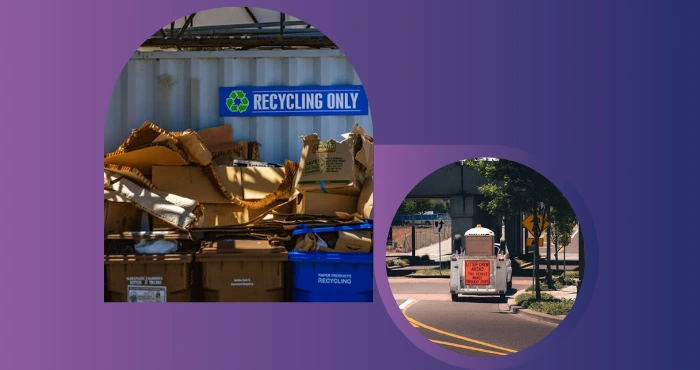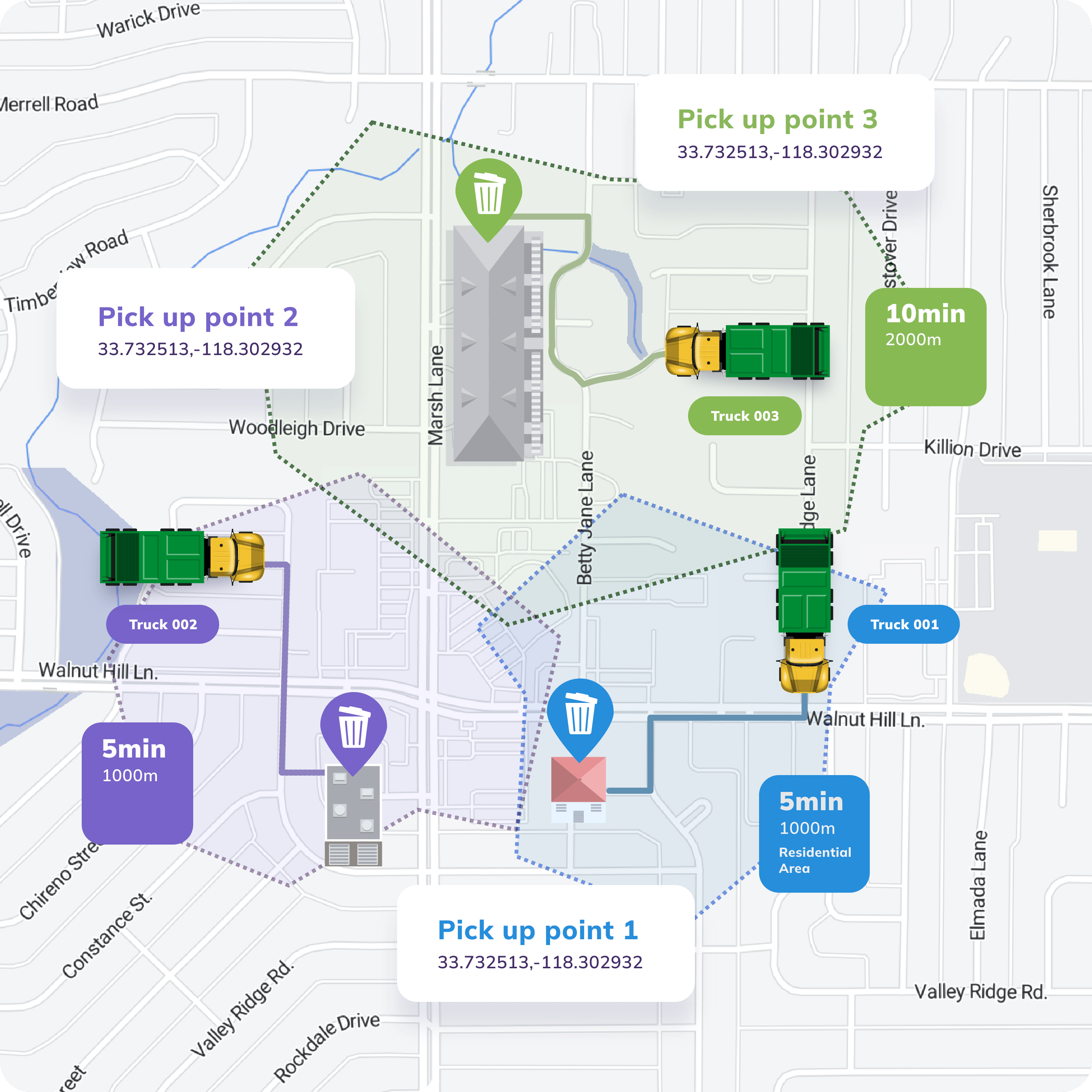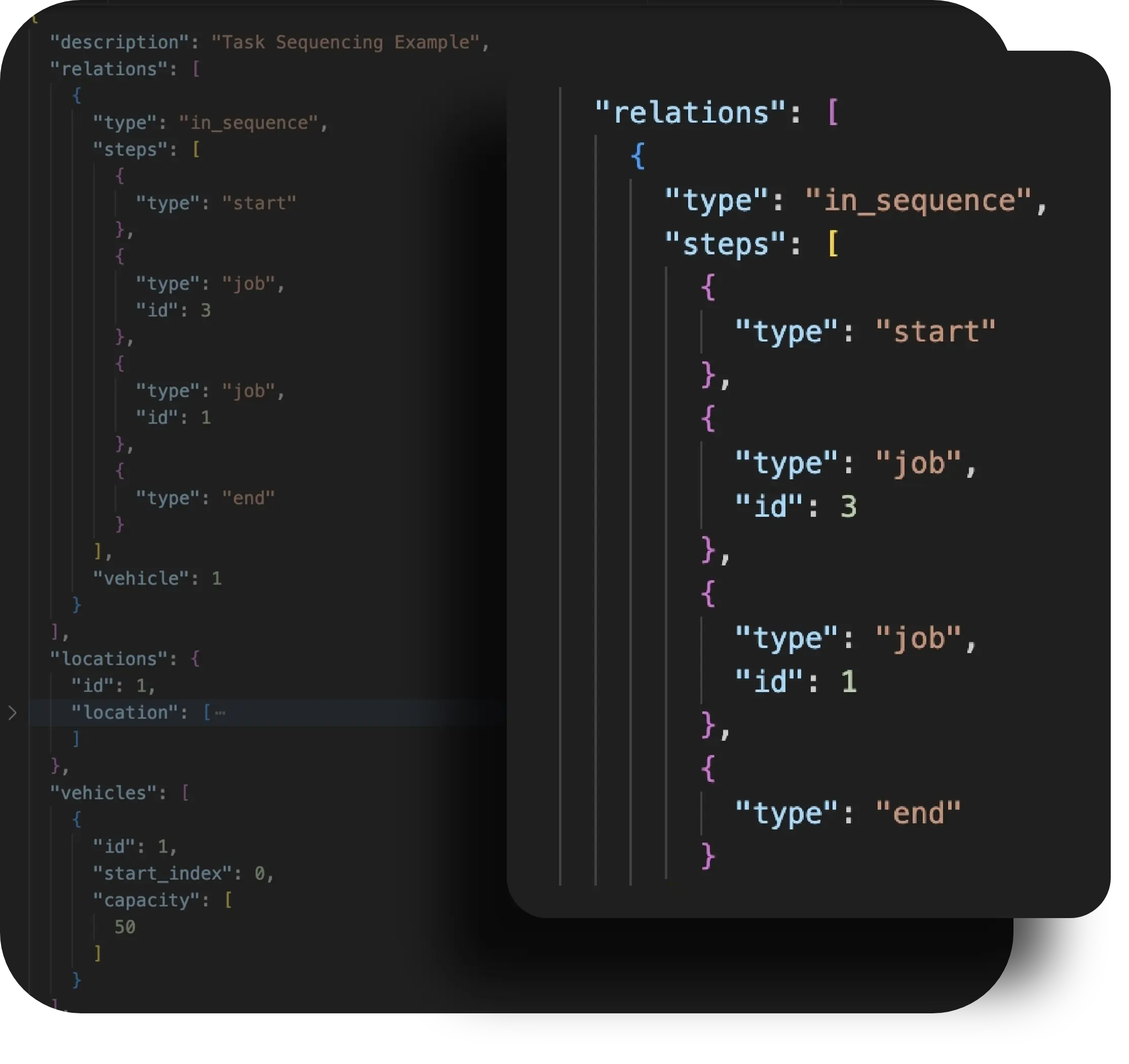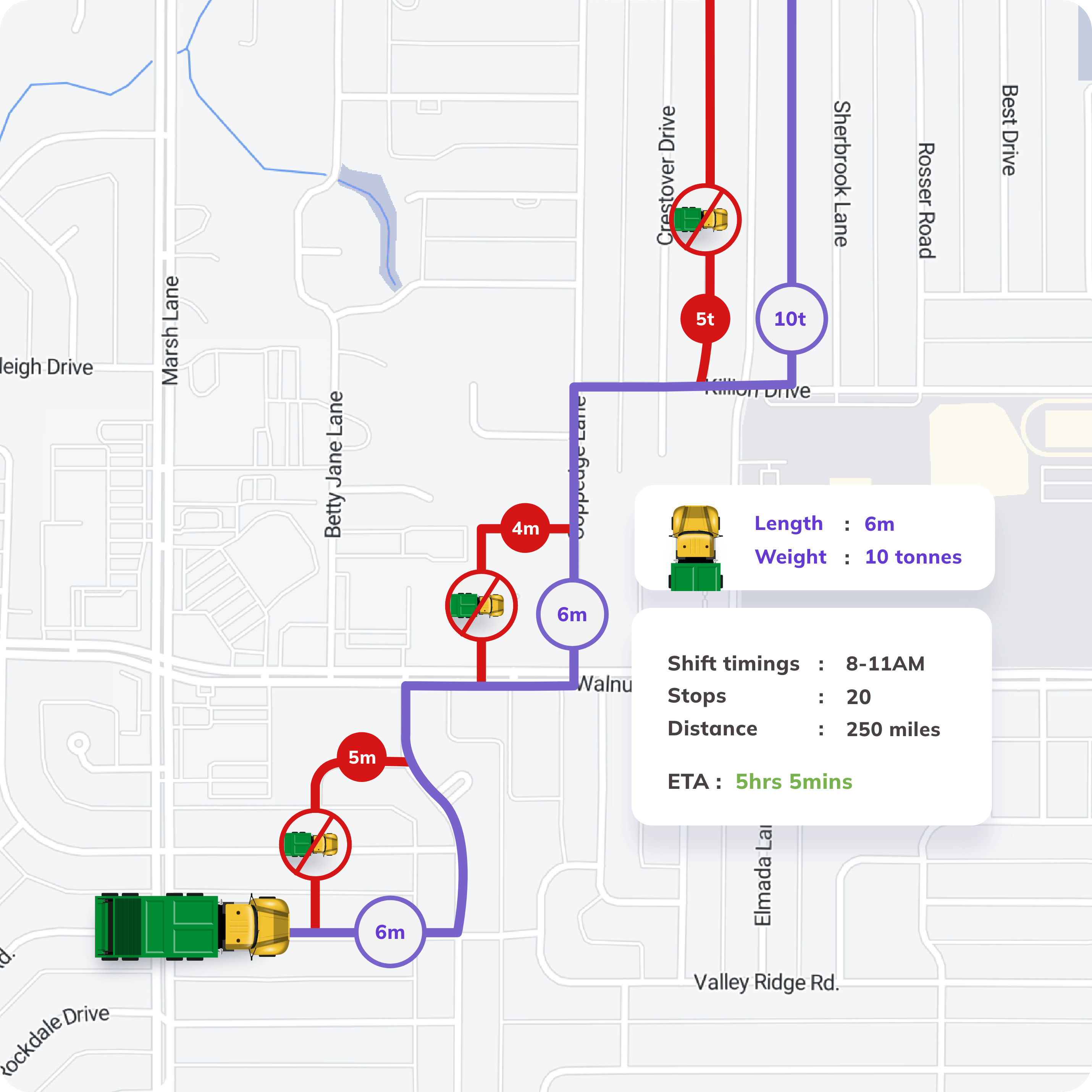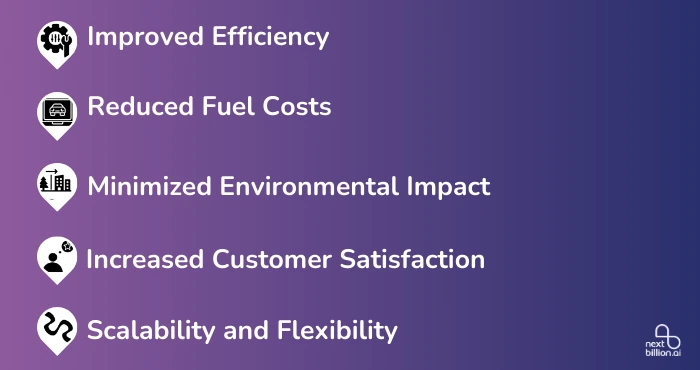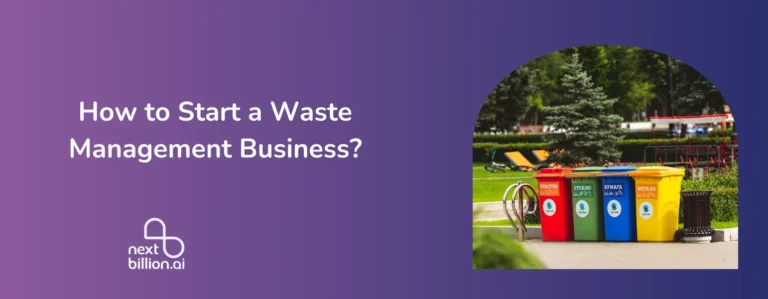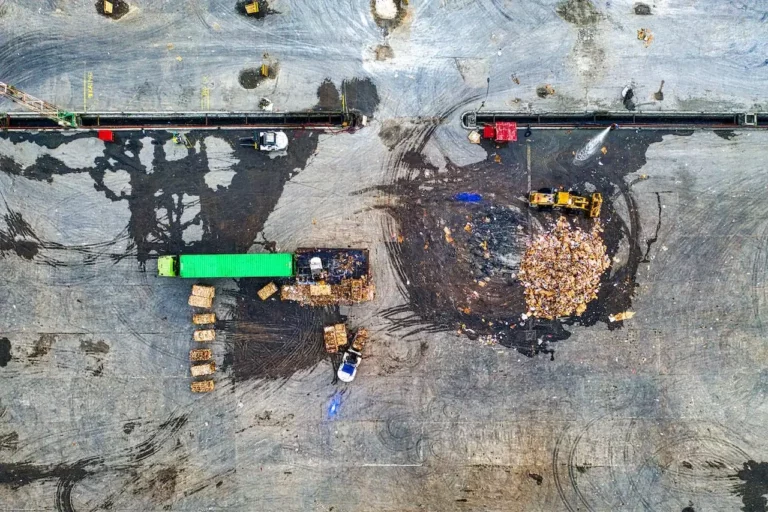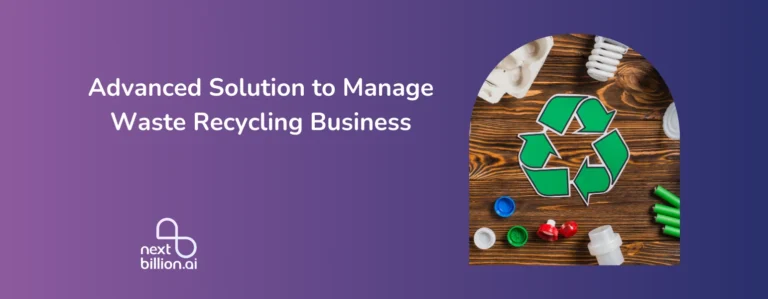
Table of Contents
Waste collection companies face increasing pressure to operate efficiently while minimizing their environmental footprint. Route optimization help waste management organizations streamline operations, reduce fuel consumption, and reduce emissions.
With technological advancements, route optimization has evolved beyond simply finding the shortest path. It now incorporates real-time data, AI-driven algorithms, and sustainability goals.
This guide will explore how modern route optimization software can revolutionize waste collection processes, ensuring a cleaner future while driving operational success.
What is Waste Collection Route Optimization?
Waste collection route optimization refers to planning and organizing the most efficient routes for waste collection vehicles. It uses advanced software and algorithms to determine the best possible paths that minimize distance, time, and fuel consumption while maximizing the number of pickups per trip. This process considers factors such as traffic patterns, road conditions, vehicle capacities, and service schedules.
In the context of waste management, route optimization addresses common operational challenges like unpredictable traffic, varying waste volumes, and the need for timely collections. By creating optimized routes, waste collection companies can significantly reduce operational costs, improve service efficiency, and lessen their environmental impact.
Unlike traditional manual planning, modern route optimization solutions have AI and real-time data processing. This allows waste management teams to dynamically adjust routes based on changing conditions, such as road closures or unanticipated increases in waste volumes. The result is a more responsive, cost-effective, and sustainable approach to waste collection.
Route optimization streamlines operations and contributes to the broader goals of reducing greenhouse gas emissions and improving urban waste management systems.
Challenges in Waste Collection Route Optimization
Optimizing routes for waste collection is crucial, but it comes with unique challenges that can complicate even the best-laid plans. Waste collection isn’t as predictable as other delivery-based industries, and various factors can disrupt efficient routing. Below are some of the primary challenges waste management companies face in route optimization:
1. Variable Waste Volumes
Waste production fluctuates greatly depending on the location, time of year, and specific customer needs. Residential areas may produce more waste during holidays, while commercial zones can experience spikes based on business activity. Predicting these variations accurately makes designing routes that account for capacity constraints without frequent adjustments challenging.
2. Unpredictable Traffic Conditions
Traffic patterns can change suddenly due to accidents, road closures, or local events. Waste collection vehicles often operate during peak traffic hours, which can lead to delays, increased fuel consumption, and longer routes. Without real-time data, route planners may struggle to adapt to these changes on the go.
3. Legal and Regulatory Restrictions
Certain areas may have specific restrictions, such as noise ordinances limiting the hours in which waste collection occurs. Additionally, there may be weight limits on certain roads or zoning restrictions that dictate which types of waste can be collected in certain areas. Balancing these regulations with operational efficiency can be a complex puzzle.
4. Diverse Road Conditions
Urban, suburban, and rural routes vary widely regarding road quality, accessibility, and density. Narrow streets, dead-ends, or unpaved rural roads can all pose challenges for large waste collection vehicles. Route optimization must consider these factors to avoid inefficiencies and minimize vehicle wear and tear.
5. Fleet and Equipment Limitations
Different waste collection vehicles have varying capacities, maneuverability, and fuel efficiency. The type of waste being collected—whether it’s recyclables, organic waste, or general refuse—can also dictate what equipment is used. Planning routes that maximize fleet utilization while considering the limitations of each vehicle type is a critical challenge in route optimization.
6. Customer-Specific Needs
Some customers, particularly commercial clients, may have specific collection schedules or service requirements. For example, businesses with hazardous waste may need specialized pickups, or residential areas might request services on a particular day of the week. Balancing these customer demands with overall route efficiency adds an additional layer of complexity.
7. Environmental Impact
Incorporating sustainability goals into route optimization presents another challenge. Waste management companies are increasingly focused on reducing their carbon footprint, which means minimizing fuel consumption and emissions. Striking the right balance between operational efficiency and environmental sustainability requires sophisticated planning and real-time monitoring tools.
Addressing these challenges in waste collection route optimization requires a combination of advanced technology, real-time data analysis, and flexible planning. By overcoming these hurdles, waste management companies can achieve more efficient routes, reduce costs, and contribute to a more sustainable future.
How Route Optimization Solves These Problems
With modern tools, waste management companies can streamline their operations, reduce fuel consumption, and improve service quality. Below are key ways advanced technology is transforming waste collection route optimization:
1. Route Optimization Software
At the core of efficient waste collection is specialized route optimization software. These platforms use algorithms to analyze multiple variables, such as traffic patterns, road conditions, waste volumes, and vehicle capacities. The software then generates the most efficient routes for collection vehicles. By factoring in real-time data, it can dynamically adjust routes in response to changing conditions, such as accidents, road closures, or unexpected delays.
Check out NextBillion.ai’s Waste Collection Solution.
2. Telematics and GPS Tracking
Telematics and GPS technology enable waste collection companies to track vehicles in real-time. With precise location data, fleet managers can monitor routes as they unfold, reroute vehicles to avoid traffic, and ensure adherence to planned schedules. This level of visibility allows for more responsive management, reducing downtime and fuel wastage.
GPS tracking also provides historical data, allowing companies to identify inefficiencies in existing routes and adjust them for future collections.
3. AI and Machine Learning
Artificial intelligence (AI) and machine learning algorithms are revolutionizing waste collection route optimization by predicting patterns based on historical data. These technologies can analyze factors such as seasonal waste volume variations, customer service preferences, and traffic patterns to create more efficient routes.
Machine learning models improve over time by learning from past route data and adjusting future route suggestions to minimize waste collection time, reduce fuel consumption, and optimize fleet usage.
4. Internet of Things (IoT) Sensors
IoT sensors are becoming a game-changer in waste management, particularly with smart waste bins. These bins are equipped with sensors that monitor fill levels in real time, alerting collection teams when they’re near capacity. By integrating these data points with route optimization software, waste collection can be scheduled only when necessary, reducing unnecessary trips and maximizing vehicle utilization.
For example, in urban areas where waste production fluctuates, IoT-enabled bins allow for a more responsive, demand-driven collection model, reducing both operational costs and environmental impact.
5. Real-Time Traffic and Weather Data
Advanced route optimization software now integrates real-time traffic and weather data to ensure the most efficient routes are followed. Sudden traffic jams, accidents, or bad weather can cause delays and increase fuel consumption. By using real-time data feeds, waste collection routes can be dynamically adjusted to avoid these issues, ensuring that collections stay on schedule.
Additionally, weather data can help predict how conditions such as rain or snow may impact waste volumes and road conditions, allowing for more proactive route planning.
6. Mobile Applications for Drivers
Equipping waste collection drivers with mobile apps ensures that they receive up-to-date route information and any adjustments made throughout their shift. These applications provide turn-by-turn navigation, real-time traffic alerts, and job updates, making it easier for drivers to follow optimized routes.
Drivers can also report issues—such as blocked roads or vehicle breakdowns—directly through the app, which can trigger rerouting in real time to prevent further disruptions.
7. Data Analytics and Reporting
Advanced technology allows waste management companies to gather and analyze vast amounts of data from their operations. Route optimization software often includes data analytics tools that provide insights into fuel consumption, vehicle usage, and route performance. These insights allow companies to refine their operations continuously, identify inefficiencies, and track improvements over time.
Additionally, data-driven reports help companies meet sustainability goals by analyzing carbon emissions and suggesting ways to reduce their environmental impact.
Benefits of Advanced Technology in Waste Collection
By leveraging advanced technology, waste management companies can:
- Reduce fuel costs by optimizing routes and minimizing vehicle idle time.
- Enhance service quality by ensuring timely and efficient pickups.
- Lower emissions and contribute to sustainability goals by minimizing route lengths and fuel usage.
- Improve fleet utilization by making smarter decisions about vehicle allocation and maintenance.
- Adapt in real time to unexpected changes such as traffic delays or fluctuating waste volumes.
Implementing these technologies allows companies to not only optimize routes but also create a more sustainable and cost-effective waste management operation.
Predictive Analytics for Demand-Based Routing
Predictive analytics looks at past data and machine learning to guess how trash will be made in the future. In this way, routes can be planned ahead of time based on expected demand, busiest times for pickup, and seasonal patterns. In turn, this makes waste management more data-driven, efficient, and good for the earth.
Top Route Optimization Software for Waste Collection in 2025
In waste management, route optimization software has become indispensable for companies seeking to enhance operational efficiency and reduce costs. The right software can streamline waste collection processes, optimize resource utilization, and ensure timely service delivery. Below, we explore some of the top route optimization solutions for waste collection in 2025, highlighting their unique features and capabilities.
1. NextBillion.ai’s Route Optimization API
NextBillion.ai stands out as one of the premier route optimization solutions for waste collection. Its comprehensive API offers a suite of features designed to address the unique challenges faced by waste collection agencies. Here’s what makes it a top choice:
Zone-Based Allocations
This feature allows waste management companies to define operational zones for specific vehicles. By configuring zones dynamically, organizations can avoid overlapping coverage and longer travel distances, ultimately improving service delivery. This also enables drivers to operate within familiar neighborhoods, enhancing their efficiency and effectiveness.
Maximum Waiting Time Constraints
The API provides hard constraints for maximum waiting time at collection points, which is crucial for consumer-facing services. This capability allows companies to manage wait times effectively, ensuring that drivers spend minimal time idling at each stop.
Custom Objective for Equal Task Distribution
This feature empowers waste management firms to pursue objectives that go beyond merely minimizing travel costs. Organizations can distribute tasks equally among routes, optimize resource utilization, and enhance workforce management, ensuring that no single vehicle is overburdened.
Task Sequencing
With task sequencing, users can specify relationships between different tasks that must be performed in a particular order. This capability is vital for ensuring compliance with special collection requirements, such as handling medical waste separately from organic waste.
Order and Route Grouping
NextBillion.ai allows for order grouping, which simplifies the planning of multiple tasks located nearby by treating them as a single stop. Additionally, route grouping helps minimize back-and-forth movement, promoting more efficient route execution, especially with large sets of orders.
Truck-Compliant Routes
The API ensures that routes are optimized based on truck specifications, such as size and weight, including compliance with hazardous material regulations. This feature is crucial for waste collection vehicles that must navigate various road conditions and restrictions.
2. Route4Me
Route4Me is another robust route optimization software favored by waste collection agencies. It offers a user-friendly interface and powerful algorithms to optimize routes efficiently. Key features include:
- Real-Time Route Adjustments: Route4Me provides real-time updates based on traffic conditions, allowing waste collection teams to adapt quickly to unforeseen circumstances.
- Multi-Stop Route Planning: Users can input multiple collection points, and the software automatically generates the most efficient route, saving both time and fuel costs.
- Mobile Application: The mobile app allows drivers to access optimized routes on the go, ensuring they have the latest information for efficient navigation.
3. OptimoRoute
OptimoRoute is designed for companies that require both route optimization and workforce management capabilities. Its features include:
- Dynamic Route Optimization: The software adjusts routes on the fly based on real-time conditions, improving responsiveness to changing situations.
- Task Management: OptimoRoute allows for effective task assignment, ensuring that drivers are well-utilized and workloads are evenly distributed.
- Analytics and Reporting: The platform provides detailed analytics to help managers assess performance, enabling continuous improvement in waste collection operations.
4. Tookan
Tookan focuses on streamlining logistics and delivery processes, making it a suitable option for waste collection operations. Its features include:
- Automated Scheduling: The software automates the scheduling of waste collection, optimizing routes based on various factors such as traffic, time, and service requirements.
- Driver App: Drivers can use the Tookan app to receive real-time updates, navigation instructions, and communicate with the management team.
- Performance Tracking: Tookan offers robust performance tracking features that allow managers to evaluate driver efficiency and operational effectiveness.
5. GetSwift
GetSwift is a powerful logistics management platform that also caters to waste collection needs. Key features include:
- Optimized Dispatching: GetSwift automates dispatching, ensuring that vehicles are allocated efficiently based on proximity to collection points.
- Customer Communication: The platform allows for seamless communication with customers, enhancing service delivery and customer satisfaction.
- Integration Capabilities: GetSwift integrates easily with existing systems, making it a flexible choice for waste management companies looking to enhance their operations.
Expert Tips for Route Optimization in Waste Management
Optimizing waste collection routes can significantly enhance operational efficiency, reduce costs, and improve service delivery. Here are some expert tips to help waste management companies implement effective route optimization strategies:
1. Utilize Advanced Route Optimization Software
Invest in advanced route optimization software, such as NextBillion.ai’s Route Optimization API, which offers robust features like zone-based allocations, maximum waiting time constraints, and real-time adjustments. These tools can automate route planning and adapt to changing conditions, ensuring your waste collection operations remain efficient and responsive.
2. Leverage Historical Data
Analyze historical data on waste collection patterns, traffic conditions, and operational challenges. Understanding past performance can help identify bottlenecks and inefficiencies in your current routes. Use this information to inform your optimization strategies, allowing for more accurate predictions of future collection needs.
3. Implement Zone-Based Allocations
Use zone-based allocations to manage vehicle assignments more effectively. By designating specific vehicles to operate in particular zones, you can reduce travel distances, minimize overlapping coverage, and leverage drivers’ familiarity with certain neighborhoods. This approach enhances service quality and reduces operational costs.
4. Prioritize High-Demand Areas
Focus your waste collection efforts on high-demand areas to ensure timely service. Implement a priority system that considers the frequency of waste collection requests and the types of waste generated in different regions. By prioritizing collection in these areas, you can optimize resource allocation and improve overall service efficiency.
5. Consider Vehicle Capabilities
Ensure that your route optimization strategy takes into account the specific capabilities and limitations of your vehicles. For instance, certain routes may not be suitable for larger trucks or vehicles carrying hazardous materials. Use software that can generate truck-compliant routes, ensuring safety and compliance with regulations.
6. Schedule Regular Maintenance Checks
Regular vehicle maintenance is essential for ensuring that your waste collection fleet operates efficiently. Schedule routine checks to prevent breakdowns that can disrupt collection schedules. By maintaining your vehicles in optimal condition, you can reduce downtime and enhance overall route efficiency.
7. Incorporate Real-Time Traffic Data
Integrate real-time traffic data into your route optimization software. This allows your drivers to avoid congested areas and road closures, ensuring timely collections. Adjust routes dynamically based on current conditions to improve responsiveness and minimize delays.
8. Train Your Drivers
Provide comprehensive training for your drivers on route optimization software and best practices. Educated drivers are more likely to follow optimized routes, manage time effectively, and utilize their local knowledge to enhance service delivery. Encourage communication between drivers and dispatch teams to address challenges quickly.
9. Review and Refine Your Routes Regularly
Route optimization is not a one-time effort. Regularly review and refine your routes based on changing conditions, customer feedback, and operational data. Continuously assess performance metrics and make necessary adjustments to improve efficiency and service quality.
10. Encourage Feedback from Drivers and Customers
Gather feedback from drivers and customers to identify areas for improvement in your waste collection processes. Drivers may have insights into route challenges and customer preferences, while customers can provide valuable input on service quality and timing. Use this feedback to enhance your route optimization strategy.
Different Types of Waste Collection
Effective waste management involves various methods of waste collection tailored to specific types of waste and the needs of the communities being served. Understanding these different types can help waste management companies optimize their operations, improve recycling rates, and enhance overall service delivery. Here are the primary categories of waste collection:
1. Residential Waste Collection
Residential waste collection involves the regular pickup of waste generated by households. This typically includes:
- General Waste: Non-recyclable items such as food scraps, packaging materials, and other household waste that cannot be reused or recycled.
- Recyclable Waste: Materials that can be processed and repurposed, including paper, plastics, glass, and metals. Many municipalities provide separate bins for recyclables to promote recycling efforts.
- Organic Waste: Biodegradable waste, such as food scraps and yard waste, is often collected separately to be composted. This type of collection helps reduce landfill waste and supports sustainable practices.
2. Commercial Waste Collection
Commercial waste collection focuses on waste generated by businesses, offices, and institutions. This category includes:
- General Business Waste: Similar to residential waste but often larger in volume. Businesses may produce more packaging materials, discarded equipment, and office supplies.
- Hazardous Waste: Certain industries, like healthcare and manufacturing, generate hazardous materials that require specialized handling and disposal to prevent harm to people and the environment.
- Construction and Demolition Debris: Waste generated from construction sites includes materials like concrete, wood, metal, and other construction-related debris. Specialized services are often required to manage this type of waste.
3. Industrial Waste Collection
Industrial waste collection deals with waste produced by manufacturing and industrial processes. This waste can be more complex and varied, including:
- Hazardous Waste: Industrial operations may generate toxic or hazardous materials that need to be disposed of safely to avoid environmental contamination.
- Non-Hazardous Waste: This can include scrap materials, excess production materials, and packaging waste that do not pose a threat to health or the environment.
4. Electronic Waste Collection (E-Waste)
E-waste refers to discarded electronic devices, such as computers, smartphones, televisions, and appliances. Due to the hazardous materials contained in many electronic products, specialized collection methods are necessary. E-waste collection programs often include:
- Drop-off Locations: Many communities establish drop-off centers where residents can safely dispose of unwanted electronic devices.
- Scheduled Pickups: Some waste management companies offer scheduled pickups for larger e-waste items, ensuring safe disposal and recycling.
5. Bulky Item Collection
Bulky item collection addresses the disposal of large items that cannot be placed in regular trash bins. This category includes:
- Furniture: Couches, mattresses, and other large furniture items require special handling.
- Appliances: Large appliances, such as refrigerators and washing machines, often need to be collected separately due to their size and potential for containing hazardous materials.
6. Medical Waste Collection
Medical waste collection is critical for healthcare facilities, as it involves the disposal of potentially hazardous materials. This type of waste can include:
- Infectious Waste: Items contaminated with blood or bodily fluids, such as used needles, bandages, and surgical instruments.
- Pharmaceutical Waste: Expired or unused medications that require safe disposal to prevent environmental contamination.
7. Green Waste Collection
Green waste collection focuses on organic materials generated from landscaping and gardening activities. This includes:
- Yard Waste: Grass clippings, leaves, branches, and other plant debris are typically collected for composting or mulching.
- Food Waste: Some programs also include food scraps from kitchens, promoting composting and reducing landfill waste.
Understanding the different types of waste collection is essential for waste management companies to optimize their services and meet community needs effectively. By tailoring collection methods to the specific waste types generated, companies can enhance recycling efforts, ensure safe disposal practices, and contribute to a more sustainable future.
Read this notebook about how Route Optimization API can be used for Solid Waste Management.
Benefits of Route Optimization for Waste Collection
Route optimization plays a crucial role in enhancing the efficiency and effectiveness of waste collection operations. By leveraging advanced technologies and software solutions, waste management companies can significantly improve their services. Here are some key benefits of route optimization for waste collection:
1. Improved Efficiency
One of the primary advantages of route optimization is the enhanced operational efficiency it provides. By analyzing various factors such as traffic patterns, collection points, and vehicle capacities, route optimization software can determine the most efficient routes for waste collection. This leads to:
- Reduced Travel Time: Optimized routes minimize the distance traveled, enabling waste collection vehicles to complete their routes more quickly. This ensures that drivers spend less time on the road and more time collecting waste.
- Better Resource Allocation: With an optimized routing plan, waste management companies can allocate resources more effectively. This includes assigning the right number of vehicles to specific routes based on demand and ensuring that each truck is utilized to its full capacity.
2. Reduced Fuel Costs
Fuel costs represent a significant portion of operational expenses for waste collection companies. Route optimization can lead to substantial savings in fuel consumption through:
- Minimized Distance Traveled: By planning the shortest and most efficient routes, fuel consumption is reduced. Less time spent idling in traffic or making unnecessary turns translates directly to lower fuel usage.
- Efficient Vehicle Utilization: Optimizing routes ensures that each vehicle operates at its maximum capacity. This reduces the number of trips needed to collect waste, further lowering fuel expenses.
3. Minimized Environmental Impact
In an era where sustainability is a growing concern, route optimization plays a vital role in minimizing the environmental impact of waste collection. Key aspects include:
- Lower Carbon Emissions: With reduced travel distances and optimized routes, waste collection vehicles generate fewer greenhouse gas emissions. This contributes to cleaner air and a healthier environment.
- Enhanced Recycling Rates: Efficient waste collection routes can include strategically placed recycling bins and centers, encouraging residents to recycle more. By optimizing routes, companies can ensure that recyclable materials are collected promptly, reducing contamination rates and improving overall recycling efforts.
4. Increased Customer Satisfaction
Optimized routes can also lead to improved customer satisfaction. When waste collection services are efficient and reliable, customers experience:
- Timely Collections: Route optimization ensures that waste is collected on schedule, reducing missed pickups and the associated inconveniences for residents and businesses.
- Better Communication: Advanced route optimization software often includes features for real-time tracking and communication with customers. This allows waste management companies to keep customers informed about collection schedules and any delays, enhancing transparency and trust.
5. Scalability and Flexibility
As communities grow and change, waste collection needs evolve. Route optimization offers the scalability and flexibility required to adapt to these changes effectively:
- Dynamic Routing: Many route optimization solutions can adjust in real time based on changing conditions, such as traffic patterns or newly added collection points. This adaptability allows waste management companies to respond quickly to evolving needs and maintain service quality.
- Future Expansion: As businesses and residential areas expand, optimized routes can easily accommodate new collection points without disrupting existing operations, enabling companies to grow and evolve alongside their communities.
The benefits of route optimization for waste collection are manifold, impacting efficiency, cost savings, environmental sustainability, and customer satisfaction. By implementing advanced routing solutions, waste management companies can not only streamline their operations but also contribute positively to the environment and community, ensuring a more sustainable future for waste management.
Getting Started with Waste Collection Route Optimization
Route optimization stands out as a vital strategy that enhances your operational efficiency, reduces costs, and minimizes environmental impacts in waste collection. By embracing advanced technologies and innovative solutions, you can significantly improve your service delivery while meeting the growing demands of the communities you serve.
NextBillion.ai’s Route Optimization API offers a robust solution designed specifically to tackle the complexities of waste collection. With features like zone-based allocations, flexible task sequencing, and custom objectives for task distribution, this API empowers you to optimize your operations efficiently and effectively.
By integrating NextBillion.ai’s Route Optimization API into your waste management processes, you can ensure timely collections, reduce operational costs, and enhance your commitment to sustainability. This not only benefits your organization but also positively impacts the environment and the communities you serve.
About Author
Shivangi Singh
Shivangi is a seasoned Technical Writer with a passion for simplifying technical concepts. With over 5 years of experience, she specializes in crafting clear and concise documentation for various technical products and platforms.

